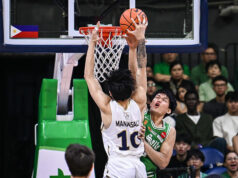The essence of martial arts

WHETHER it is making sushi, growing bonsai, drinking tea, or arranging flowers, there is art present in every aspect of Japanese culture. Beyond being a sport or methods of self defense, the martial arts are, as well, a Japanese art form.
Before becoming sports, Japanese martial arts have a very long history, starting as combat techniques used during battles. Today, many of these original martial arts are considered sports which are enjoyed by anyone, not only by the Japanese.
Scholars estimated that the foundation of the martial art schools, called ryūha, started at the end of Japan’s Heian period (794-1185).
Currently on view at the National Museum of Fine Arts is The Spirit of Budō: The History of Japan’s Martial Arts — an initiative of the Japan Foundation Manila — which tackles the history, evolution, uniforms, and tools used in Japanese martial arts.
The exhibition occupies the Museum’s Galleries XXVII and XXVIII and is ongoing until Sept. 30.
Before coming to Manila, the travelling exhibit has been to Peru, Canada, and Brazil.
“Many people, not only Filipinos, enjoy martial arts like judō and karate-dō. But they do not know the history. This is a good opportunity to know the spirit of budō, or martial arts, so that people can enjoy it more,” Hiroaki Uesugi, director of Japan Foundation in Manila, told BusinessWorld.
On view at the two adjacent galleries are bows and arrows, suits of armor, helmets, and uniforms for kyūjutsu (archery), kenjutsu (swordsmanship), and jukendō (bayonet fighting). Some, however, are only reproductions because the original pieces are too fragile for international transport.
One of the most popular Japanese martial arts is judō, a sparring sport that does not use kicks and punches but only grappling to take down an opponent — it is karate-dō which uses throws, punches, and kicks. Judō became an Olympic sport at the 1964 Tokyo Games. Both judō and karate-dō come from Japan while taekwondo comes from Korea and uses kicks only.
Filipino-Japanese karate player Junna Tsukii, 26, told BusinessWorld that those who practice martial arts learn tradition before learning techniques.
“The martial art spirit is called as bushi-dō. The first things we learn when we start karate are not the techniques, but how to bow. Bowing in karate means respecting others and never forgetting the thoughtful consideration even towards your opponent. In bushi-dō spirit, you always strive to follow the correct way, the right posture. You need justice and courage to push through,” she said at the sidelines of the event’s launch on Aug. 9.
At the opening, Ms. Tsukii demonstrated her karate skills.
Born in Pasay City to a Japanese father and Filipino mother, she moved to Japan when she was in kindergarten. She took up karate at age seven and became a five-time champion in the National Games in Japan. She returned to the Philippines last year to represent the country as a national team member and won two bronze medals in the SEA Games in Kuala Lumpur, Malaysia.
“The reason why I chose to be a national player of the Philippines, despite being brought up in Japan, is that I wanted to help Philippines through what I have learned in Japan. Karate has been [an] active [sport in the Philippines] now,” she said.
More than winning against the opponent, karate involves the synergy of body, mind, and spirit.
“Through practicing karate, you can learn many attacking techniques such as punches, kicks, and throwing, as well a blocks and sweeps to protect yourself from opponents. But what I want to tell you is that karate is not a sport, but martial arts, which requires mental health training rather than physical training,” she said.
A form of unarmed combat, karate is believed to have started in Okinawa, Japan. It is now widely practiced as a sport. According to Ms. Tsukii, in order to score points, a karateka, or a karate practitioner earns one point for a punch to the face or abdomen, two points for a kick at the face or abdomen, and three points for throwing down an opponent. But karate is a bloodless sport unlike boxing. It needs control, said Ms. Tsukii, where the karateka must not hurt their opponent. A punch or a kick should barely touch the opponent’s skin, she said.
Karate can be a sparring sport, called komite, where two karateka fight. It can also be a one-man sport called kata, where a karateka is judged based on how good his or her techniques are, just as figure skaters are judged for their moves on the ice.
The ongoing exhibition also features bujutsu, or traditional battlefield combat. While budō and bujutsu can be used interchangeably to describe martial arts, bujutsu is used more to refer to technique while the dō in budō means a way of life.
“We always say arigatou gozaimasu (thank you) and bow to show our good attitude — our ways of life — even before we learn the techniques,” said Ms. Tsukii.
According to the exhibit’s notes, swordsman and government official Nishikubo Hiromichi (1863-1930) said that Japan’s Ministry of Education should use the suffix “dō” (which means “way”) — as in judō, sumō, and kyūdō (archery) — to imply that martial arts are ways to develop physical, mental, and moral health.
Thanks to his initiative, budō remains as an official curriculum subject in junior and senior high school in Japan to this day.
“The spirit of budō comes from the samurai. It is respect for others, not only the old people but our opponents. We don’t like laban (fight). When we bow down, it means no more laban,” said Ms. Tsukii. — Nickky Faustine P. de Guzman



